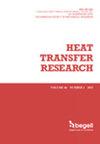Employing thin planar electrodes to expand the ionic wind flow coverage area and achieve enhanced heat dissipation
IF 1.6
4区 工程技术
Q3 THERMODYNAMICS
引用次数: 0
Abstract
The suboptimal photoelectric conversion efficiency of light-emitting diodes (LEDs) leads to increased temperature. There is a growing interest in using micro-structure ionic wind pumps to regulate the chip temperature. But the ionic wind flow and thermal transfer characteristics of thin-plate electrode pumps used for cooling LED chips is unclear. This study proposes ionic wind pumps equipped with wedged and zigzag-emitters to effectively manage the heat generated by high-power LED chips. Experimental investigations were conducted to analyze the electrohydrodynamic characteristics of pumps with different emitter types. A two-dimensional model with a wedged-electrode and a three-dimensional model with a zigzag-electrode were developed for flow distribution analysis and energy efficiency comparison. The cooling capacity of pumps with different configurations was examined. The results show that the pump equipped with a zigzag-electrode exhibits improved stability in corona discharge and approximately 1.53 times higher energy efficiency compared to the pump with a wedged-electrode. Moreover, the pump with the zigzag-electrode covers a larger area, generating a higher intensity of ionic wind. The angle between the emitter and the ground electrode significantly affects the characteristics of the characteristics of the ionic wind flow. The optimal angle is 70° for pumps with wedged-emitters and 30° for those with zigzag emitters. Both pumps can produce a steady wall jet at their optimal angle, causing significant disruption in the surrounding area. The pump with zigzag-electrode exhibits superior cooling performance and is more effective with low power consumption.采用薄平面电极,扩大离子风流覆盖面积,增强散热效果
发光二极管(LED)的光电转换效率不理想会导致温度升高。人们对使用微结构离子风泵调节芯片温度的兴趣与日俱增。但用于冷却 LED 芯片的薄板电极泵的离子风流和热传导特性尚不清楚。本研究提出了配备楔形和人字形发射器的离子风泵,以有效管理大功率 LED 芯片产生的热量。实验研究分析了具有不同发射器类型的泵的电动流体力学特性。开发了楔形电极的二维模型和人字形电极的三维模型,用于流量分布分析和能效比较。研究了不同配置水泵的冷却能力。结果表明,与采用楔形电极的泵相比,采用人字形电极的泵在电晕放电时表现出更高的稳定性,能效大约高出 1.53 倍。此外,装有人字形电极的泵覆盖面积更大,产生的离子风强度更高。发射器和接地电极之间的角度对离子风流的特性有很大影响。楔形发射器泵的最佳角度为 70°,人字形发射器泵的最佳角度为 30°。这两种泵都能在最佳角度产生稳定的壁面射流,对周围区域造成严重破坏。人字形电极泵的冷却性能更优越,功耗更低。
本文章由计算机程序翻译,如有差异,请以英文原文为准。
求助全文
约1分钟内获得全文
求助全文
来源期刊

Heat Transfer Research
工程技术-热力学
CiteScore
3.10
自引率
23.50%
发文量
102
审稿时长
13.2 months
期刊介绍:
Heat Transfer Research (ISSN1064-2285) presents archived theoretical, applied, and experimental papers selected globally. Selected papers from technical conference proceedings and academic laboratory reports are also published. Papers are selected and reviewed by a group of expert associate editors, guided by a distinguished advisory board, and represent the best of current work in the field. Heat Transfer Research is published under an exclusive license to Begell House, Inc., in full compliance with the International Copyright Convention. Subjects covered in Heat Transfer Research encompass the entire field of heat transfer and relevant areas of fluid dynamics, including conduction, convection and radiation, phase change phenomena including boiling and solidification, heat exchanger design and testing, heat transfer in nuclear reactors, mass transfer, geothermal heat recovery, multi-scale heat transfer, heat and mass transfer in alternative energy systems, and thermophysical properties of materials.
 求助内容:
求助内容: 应助结果提醒方式:
应助结果提醒方式:


